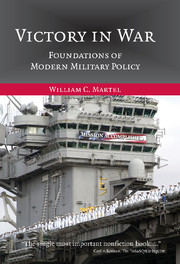Book contents
- Frontmatter
- Contents
- Acknowledgments
- 1 Introduction
- 2 Historical Origins of Victory
- 3 Modern Origins of Victory
- 4 Foundations of Victory
- 5 America's Theory of Victory
- 6 1986 Raid on Libya
- 7 1989 Invasion of Panama
- 8 1991 Persian Gulf War
- 9 Bosnia and Kosovo, 1992–1999
- 10 2001 Invasion of Afghanistan
- 11 2003 Invasion of Iraq
- 12 Military Power and Victory
- 13 Conclusions
- Notes
- Index
7 - 1989 Invasion of Panama
Published online by Cambridge University Press: 05 June 2012
- Frontmatter
- Contents
- Acknowledgments
- 1 Introduction
- 2 Historical Origins of Victory
- 3 Modern Origins of Victory
- 4 Foundations of Victory
- 5 America's Theory of Victory
- 6 1986 Raid on Libya
- 7 1989 Invasion of Panama
- 8 1991 Persian Gulf War
- 9 Bosnia and Kosovo, 1992–1999
- 10 2001 Invasion of Afghanistan
- 11 2003 Invasion of Iraq
- 12 Military Power and Victory
- 13 Conclusions
- Notes
- Index
Summary
In a resolution issued on December 15, 1989, the National Assembly of Panama declared that a state of war existed with the United States. Shortly after, members of the Panama Defense Forces (PDF) shot three American officers, one of whom died. On December 17, 1989, President George H. W. Bush ordered the invasion of Panama, called Operation Just Cause, which began on December 20, 1989. The stated purpose of this military action, which involved 22,000 soldiers, 3,400 airmen, 900 Marines, and 700 sailors, was to remove General Manuel Antonio Noriega, who was the head of the PDF, and restore a democratic government to Panama. As Secretary of State James Baker said, the United States took military action because it has an “inherent right of self-defense” in matters that affect the security of the Panama Canal and the region.
Under the leadership of General Noriega, Panama had been plagued in the 1980s by massive corruption that was related to the government's active involvement in drug smuggling in Central America, which had progressively disrupted ordinary economic activity and fostered a climate of fear and anxiety in Panama. On December 20, at 1 a.m. local time, the U.S. military attacked key targets in Panama to destroy the authoritarian and brutal regime of Noriega. As President Bush explained in an address to the nation on the morning of the invasion, the goals of the United States were “to protect the lives of American citizens in Panama and to bring General Noriega to justice in the United States.” While this “war” was over within hours, it took almost two weeks to capture Noriega.
- Type
- Chapter
- Information
- Victory in WarFoundations of Modern Military Policy, pp. 164 - 177Publisher: Cambridge University PressPrint publication year: 2006



